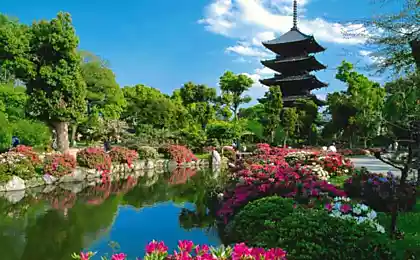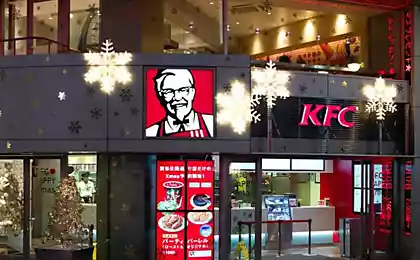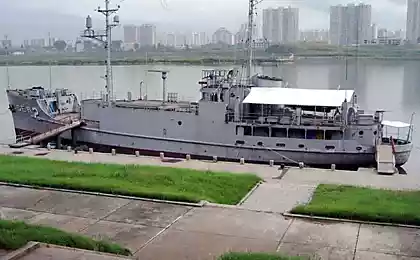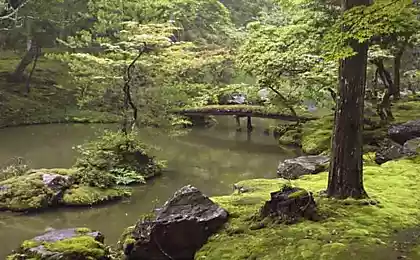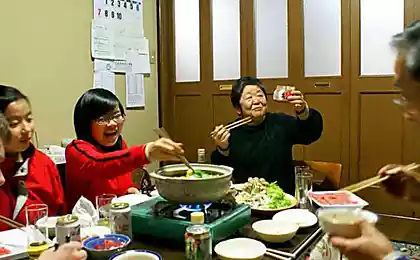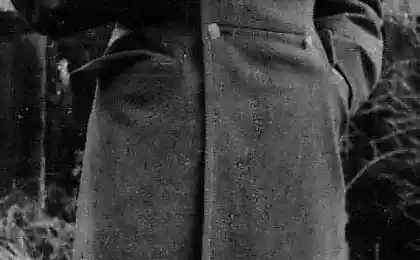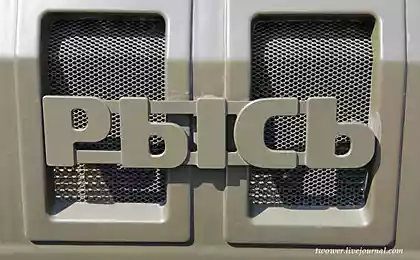656
On the Japanese "grazing"
It's time to talk about the "informal" food format. Without this aspect of Japanese blog is obviously incomplete. Traveling with a small child who has to be put to bed in his usual time - nine o'clock in Khabarovsk, ie 19 hours Japan time, excluded the possibility of dinner in a cafe or restaurant. As a result, we were buying food in stores and ate in the room by the light of city lights and starry sky.
Will be 23 photos and comments of the author.
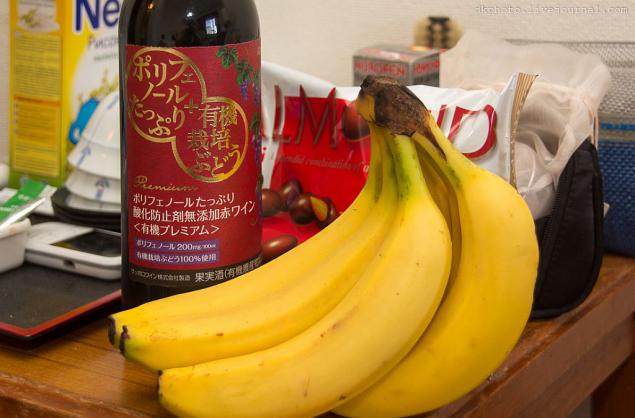
2.Very convenient that in the Japanese cities to the nearest combinations, that is, the concept of self-service store "closer to home" will never have to walk more than five minutes. The most common network - '7-Eleven', 'FamilyMart' and 'Lowson Store'. There are, however, and other brands, networks are more modest (and perhaps and at all individual stores), but they seemed to me, the range is worse, and prices are higher.
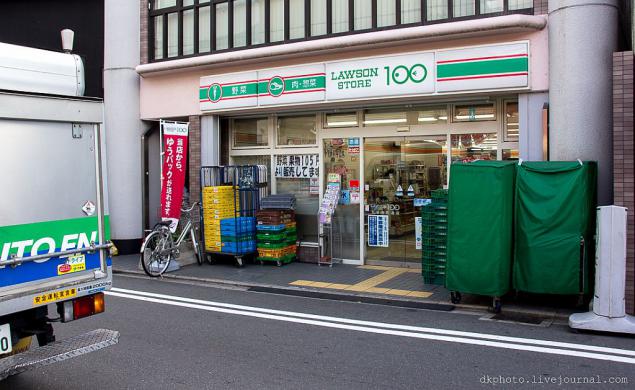
3.Prodayutsya in Combine items that may be needed every day, but for whom it may be once or too lazy to go to the big hypermarkets. This variety of products (mainly semi-finished products) and beverages (including alcohol) and household cleaning products and personal care products, and animal feed, and the press comics ...
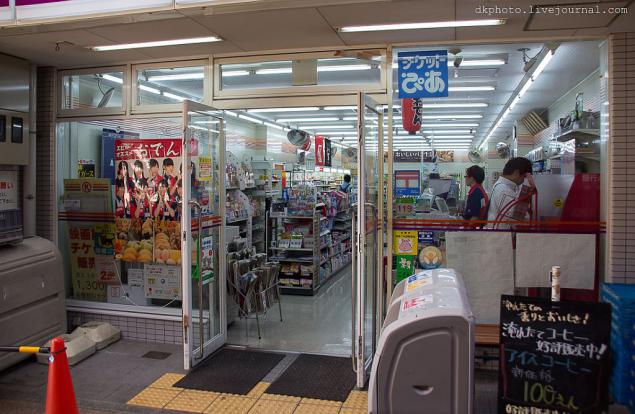
4.Chestno speaking, from all the surrounding shops I looked mainly in '7-Eleven', where I liked more than the choice of products, but something I bought in dragstore, for example, local wine (pretty decent for Asia, much better , for example, Korean), and chocolate-covered almonds. By the way, a network of '7-Eleven' has moved far beyond the Japanese islands. Perhaps the franchise she successfully works in the same Thailand, unlocking about the same standards. The disadvantage from the network, from the perspective of a tourist, only one - often sellers did not speak in English.
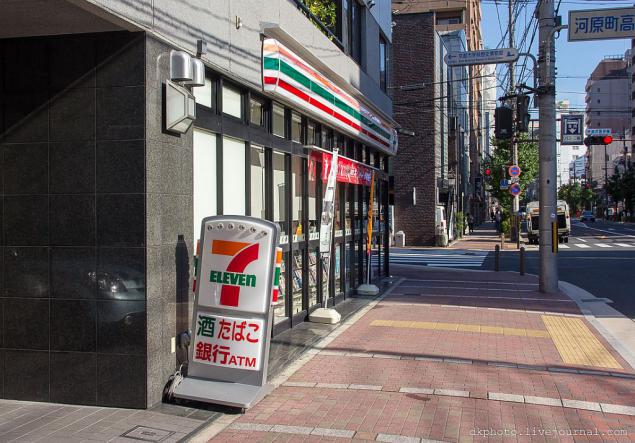
5.Vo any and all combinations purchased semi-finished products can be immediately free warm. A number of shops it makes the staff somewhere, such as in the 'Fresco', self-service. However, control of microwave at all the same invariable Japanese. In addition, you can take everywhere disposable chopsticks-fork-spoon-tube; sometimes they are freely available, sometimes issued by the seller.

6.To that in English-speaking countries is called the lunchbox in Japan called bento. Traditionally, it is a flat aluminum box, or bast. Vsevolod Ovchinnikov describes the structure of a conventional Japanese lunch - boiled rice, put there with a piece of fried flounder and a few slices of pickled vegetables. During the Second World War, it was even more modest - then a patriotic dinner, called "rising sun" meant a circle of red carrots, put on white rice. However, if you believe the memoirs of the Japanese themselves, in those years, in itself no small white rice was a luxury. Anyway, times have changed and the contents of the Japanese bento was not an example of calorie and varied.
Here, for example, bought the store bento with Seafood, vegetables and egg. Set hearty and quite tasty, if you have it in the form of heat. It costs 399 yen (or about 133 rubles); it is not the most expensive, though not the cheapest option. Other sets, especially with natural meat, are only slightly less than a full dinner in the cafe. Generally, in bento usually prevails ground meat (optional chicken or fish), breaded. In my opinion, it is not so in harmony with the popular perception of the usefulness of Japanese cuisine. But this is from the category of grumbling, in fact, such lunches or dinners allow several budget traveler save on food, and the food at the same time much tastier than in any "McDonalds."
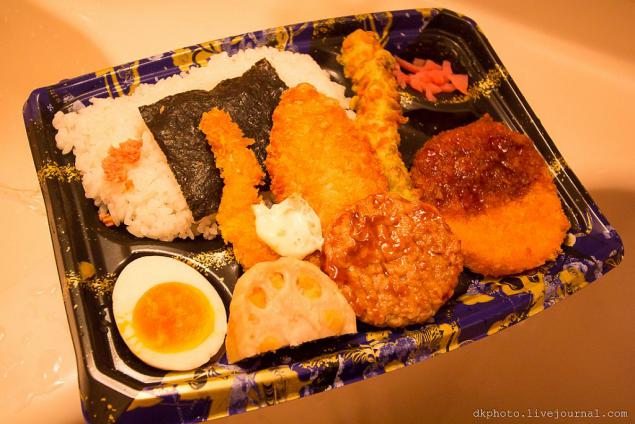
7.Esche a budget option - instant noodles. However, here it captured it's not the cheapest option - dry shrimp, etc. Bought it more out of curiosity, but it was useful, at least quite satisfying and even cheaper than the average bento.

8.Sladosti in Japan are divided into two broad categories: European-style and traditional local. The first is almost always delicious, with the second unaccustomed possible options. Photographed dessert first impression of the first: fruits in the bath with whipped cream.

9.Odnako where the contents suddenly (especially for a high enough price, it seems, about 300 yen) was over, it turned out that there is a second bath - the basement - floor. This is doubtless the Japanese delicacy. I do not know what it consists of. Several blocks like coconut pulp with some molasses. To my surprise, it was quite tasty.

10.Vitrina grocery store (not a supermarket, but not combinations) in Tokyo. As can be seen, fruits are not particularly cheap (remember to get rubles, the price must be divided into three), but on the whole is comparable with the price tags, which can be found in supermarkets Khabarovsk. Comparable in price, but the quality had grown fruits in Japan is much higher. The Chinese, by the way, too, and are sold in more than two times cheaper.
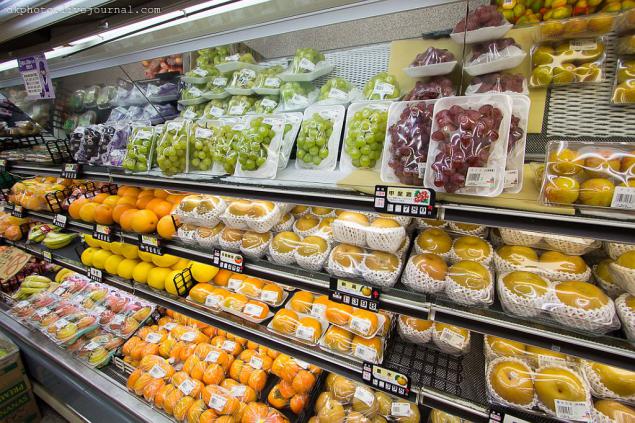
11.Myaso also worth almost as much as in Khabarovsk. Especially pay attention to what is laid out in the refrigeration Lara is not frozen and chilled products. The Japanese on the whole are generally staunch supporter of natural products.

12.Ryba, apparently, this showcase is not sold on weight and packaging. That is three pieces of salmon worth 350 yen.

13.Krab pretty cheap - only 950 yen per kilogram paws with a piece of carcass, but probably not as tasty as the Kamchatka.
In any case, all the options for those who rent an apartment with a kitchen. Of course, we do not prepare, to the grocery store, where there were no semis, looked solely out of curiosity.
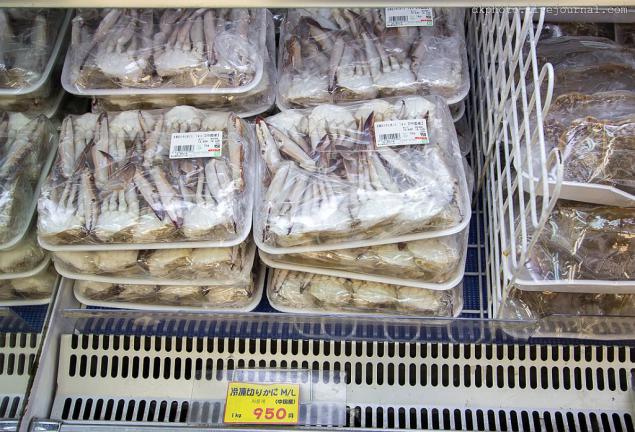
14. What concerns baby food, and it was important for us, it is almost impossible to find in combinations, though I was told otherwise. When finished stocks brought from home, they had to fill up what we have done successfully in dragstore. The selection was so-so, we have in large pharmacies, not to mention the supermarkets, the range is much wider. By the way, in baby food Japanese tend to seafood, and products are ground coarser than it is with us. Local child baby foods do not really taste had.
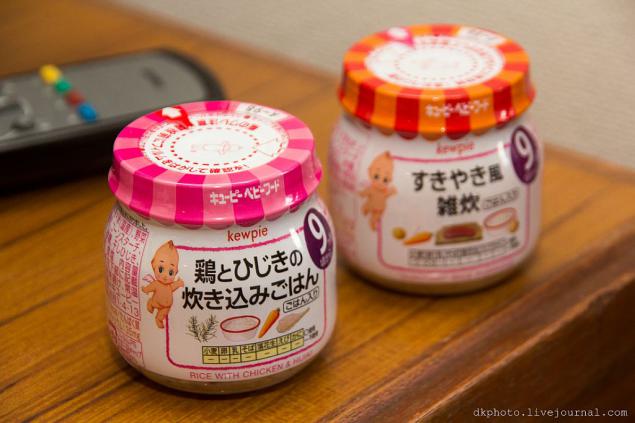
15.Ulichnaya food in Japan is also found, but rarely, and mainly in the largest tourist attractions. This is typical for Japan noticeable focus on domestic tourism. Nevertheless, price tags often duplicated in English, and the sellers themselves speak the language of Shakespeare as a minimum within the boundaries of their work.
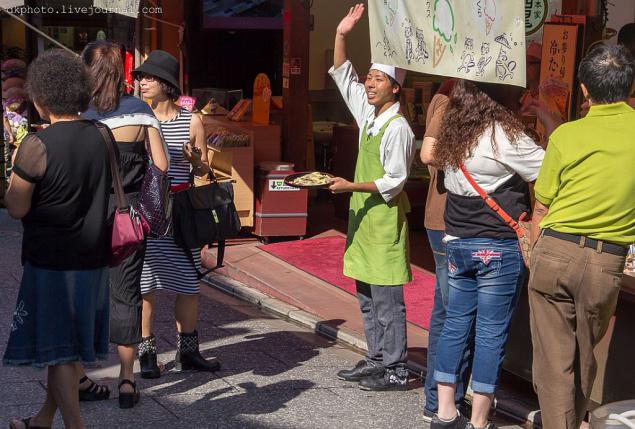
16.Morozhenoe (300 yen per horn) was amazingly delicious.
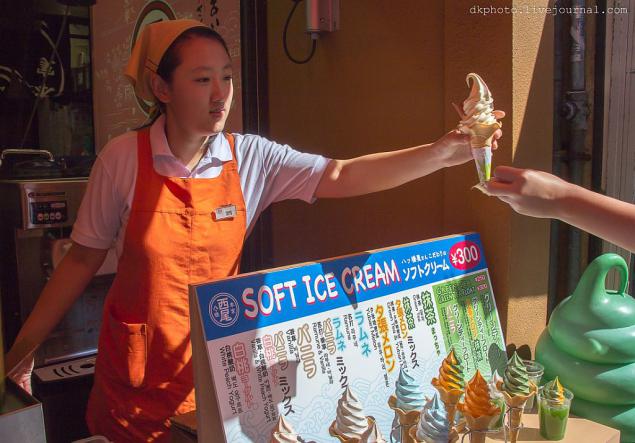
17.Sdelav step away from the topic of street food, show one more delicious ice cream, bought in the store. Both portions are tiny and are not cheap, but the taste is very, very bad.
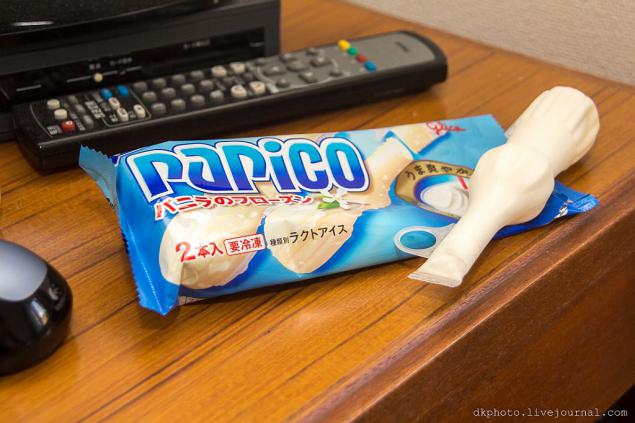
18.Zato flakes frozen strawberries I did not like at all. His 400 yen is a treat not even close.
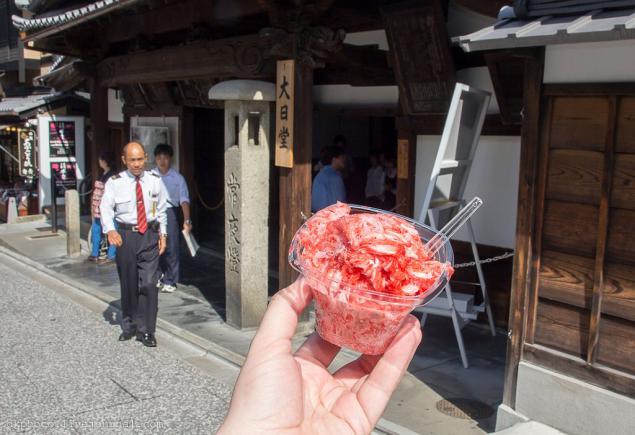
19.Esche one Japanese delicacy - salted cucumber. Unlike all familiar to us is only a stick, like a popsicle. The price of my memory, alas, is not retained, but it seems that something in the region of 150 yen.
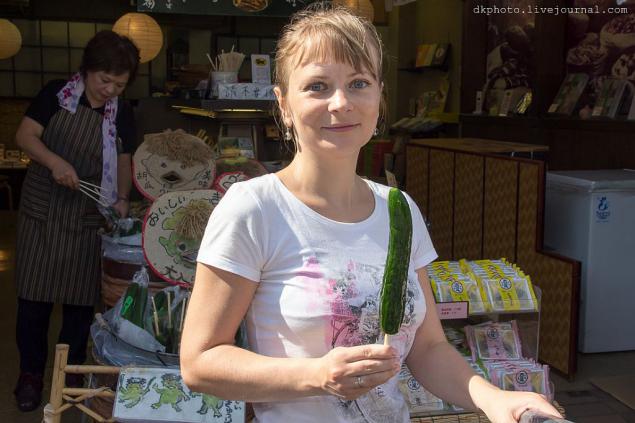
20.Vpervye in life somehow tried not roasted chestnuts in France and in Japan. Fortunately, he took a small bag of 500 yen.

21.Chestno saying dish for everybody.
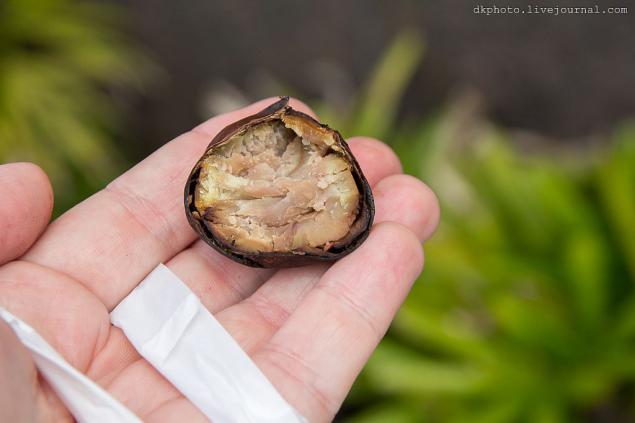
22.Vezde - on the streets, in subway stations, in shopping centers - there are vending machines for drinks. The overall range is huge, variety is provided by a large number of machines. The cost of a jar or a small bottle of drink (mineral water, tea, sweet drinks, psevdosoka) is in the range of 120-150 yen, although there are cheaper and offer a little bit more expensive. I hunted for their favorite orange "Phantom" (what the company "Coca-Cola" released in Russia - utter rubbish), but gets it quite rarely, local tastes somehow more appropriate version of the grape soda.
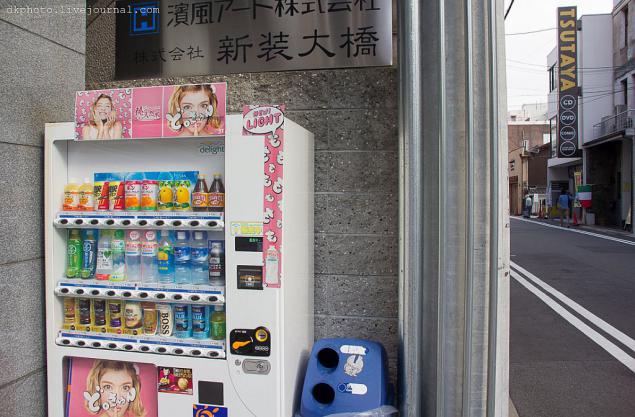
23.Nash modest breakfast before an early departure to the airport from a hotel in Tokyo. Dairy products, by the way, in Japan, very tasty, although the tradition of wide use of milk on the islands is relatively young.
That's all. Thanks to all.
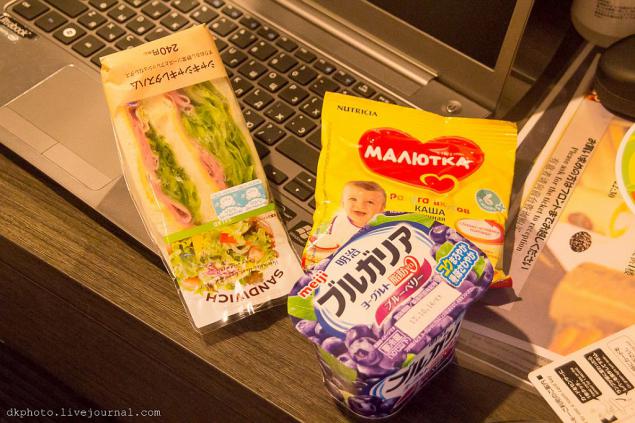
Source:
Will be 23 photos and comments of the author.

2.Very convenient that in the Japanese cities to the nearest combinations, that is, the concept of self-service store "closer to home" will never have to walk more than five minutes. The most common network - '7-Eleven', 'FamilyMart' and 'Lowson Store'. There are, however, and other brands, networks are more modest (and perhaps and at all individual stores), but they seemed to me, the range is worse, and prices are higher.

3.Prodayutsya in Combine items that may be needed every day, but for whom it may be once or too lazy to go to the big hypermarkets. This variety of products (mainly semi-finished products) and beverages (including alcohol) and household cleaning products and personal care products, and animal feed, and the press comics ...

4.Chestno speaking, from all the surrounding shops I looked mainly in '7-Eleven', where I liked more than the choice of products, but something I bought in dragstore, for example, local wine (pretty decent for Asia, much better , for example, Korean), and chocolate-covered almonds. By the way, a network of '7-Eleven' has moved far beyond the Japanese islands. Perhaps the franchise she successfully works in the same Thailand, unlocking about the same standards. The disadvantage from the network, from the perspective of a tourist, only one - often sellers did not speak in English.

5.Vo any and all combinations purchased semi-finished products can be immediately free warm. A number of shops it makes the staff somewhere, such as in the 'Fresco', self-service. However, control of microwave at all the same invariable Japanese. In addition, you can take everywhere disposable chopsticks-fork-spoon-tube; sometimes they are freely available, sometimes issued by the seller.

6.To that in English-speaking countries is called the lunchbox in Japan called bento. Traditionally, it is a flat aluminum box, or bast. Vsevolod Ovchinnikov describes the structure of a conventional Japanese lunch - boiled rice, put there with a piece of fried flounder and a few slices of pickled vegetables. During the Second World War, it was even more modest - then a patriotic dinner, called "rising sun" meant a circle of red carrots, put on white rice. However, if you believe the memoirs of the Japanese themselves, in those years, in itself no small white rice was a luxury. Anyway, times have changed and the contents of the Japanese bento was not an example of calorie and varied.
Here, for example, bought the store bento with Seafood, vegetables and egg. Set hearty and quite tasty, if you have it in the form of heat. It costs 399 yen (or about 133 rubles); it is not the most expensive, though not the cheapest option. Other sets, especially with natural meat, are only slightly less than a full dinner in the cafe. Generally, in bento usually prevails ground meat (optional chicken or fish), breaded. In my opinion, it is not so in harmony with the popular perception of the usefulness of Japanese cuisine. But this is from the category of grumbling, in fact, such lunches or dinners allow several budget traveler save on food, and the food at the same time much tastier than in any "McDonalds."

7.Esche a budget option - instant noodles. However, here it captured it's not the cheapest option - dry shrimp, etc. Bought it more out of curiosity, but it was useful, at least quite satisfying and even cheaper than the average bento.

8.Sladosti in Japan are divided into two broad categories: European-style and traditional local. The first is almost always delicious, with the second unaccustomed possible options. Photographed dessert first impression of the first: fruits in the bath with whipped cream.

9.Odnako where the contents suddenly (especially for a high enough price, it seems, about 300 yen) was over, it turned out that there is a second bath - the basement - floor. This is doubtless the Japanese delicacy. I do not know what it consists of. Several blocks like coconut pulp with some molasses. To my surprise, it was quite tasty.

10.Vitrina grocery store (not a supermarket, but not combinations) in Tokyo. As can be seen, fruits are not particularly cheap (remember to get rubles, the price must be divided into three), but on the whole is comparable with the price tags, which can be found in supermarkets Khabarovsk. Comparable in price, but the quality had grown fruits in Japan is much higher. The Chinese, by the way, too, and are sold in more than two times cheaper.

11.Myaso also worth almost as much as in Khabarovsk. Especially pay attention to what is laid out in the refrigeration Lara is not frozen and chilled products. The Japanese on the whole are generally staunch supporter of natural products.

12.Ryba, apparently, this showcase is not sold on weight and packaging. That is three pieces of salmon worth 350 yen.

13.Krab pretty cheap - only 950 yen per kilogram paws with a piece of carcass, but probably not as tasty as the Kamchatka.
In any case, all the options for those who rent an apartment with a kitchen. Of course, we do not prepare, to the grocery store, where there were no semis, looked solely out of curiosity.

14. What concerns baby food, and it was important for us, it is almost impossible to find in combinations, though I was told otherwise. When finished stocks brought from home, they had to fill up what we have done successfully in dragstore. The selection was so-so, we have in large pharmacies, not to mention the supermarkets, the range is much wider. By the way, in baby food Japanese tend to seafood, and products are ground coarser than it is with us. Local child baby foods do not really taste had.

15.Ulichnaya food in Japan is also found, but rarely, and mainly in the largest tourist attractions. This is typical for Japan noticeable focus on domestic tourism. Nevertheless, price tags often duplicated in English, and the sellers themselves speak the language of Shakespeare as a minimum within the boundaries of their work.

16.Morozhenoe (300 yen per horn) was amazingly delicious.

17.Sdelav step away from the topic of street food, show one more delicious ice cream, bought in the store. Both portions are tiny and are not cheap, but the taste is very, very bad.

18.Zato flakes frozen strawberries I did not like at all. His 400 yen is a treat not even close.

19.Esche one Japanese delicacy - salted cucumber. Unlike all familiar to us is only a stick, like a popsicle. The price of my memory, alas, is not retained, but it seems that something in the region of 150 yen.

20.Vpervye in life somehow tried not roasted chestnuts in France and in Japan. Fortunately, he took a small bag of 500 yen.

21.Chestno saying dish for everybody.

22.Vezde - on the streets, in subway stations, in shopping centers - there are vending machines for drinks. The overall range is huge, variety is provided by a large number of machines. The cost of a jar or a small bottle of drink (mineral water, tea, sweet drinks, psevdosoka) is in the range of 120-150 yen, although there are cheaper and offer a little bit more expensive. I hunted for their favorite orange "Phantom" (what the company "Coca-Cola" released in Russia - utter rubbish), but gets it quite rarely, local tastes somehow more appropriate version of the grape soda.

23.Nash modest breakfast before an early departure to the airport from a hotel in Tokyo. Dairy products, by the way, in Japan, very tasty, although the tradition of wide use of milk on the islands is relatively young.
That's all. Thanks to all.

Source:

